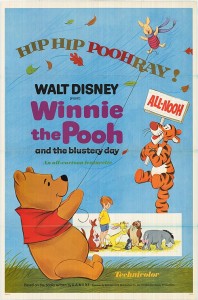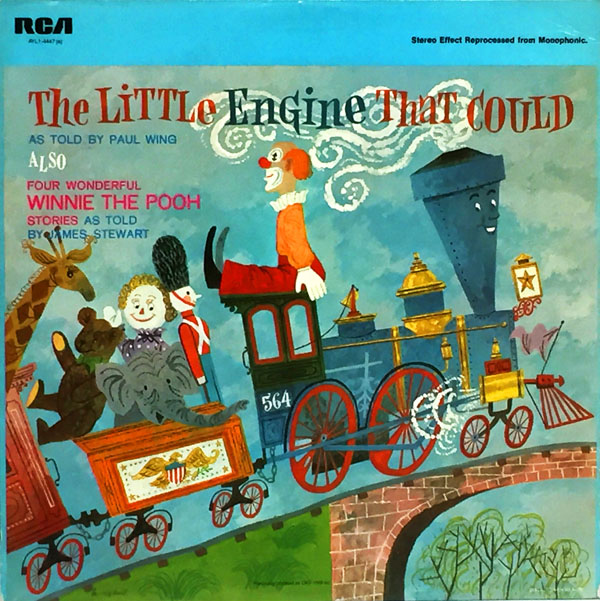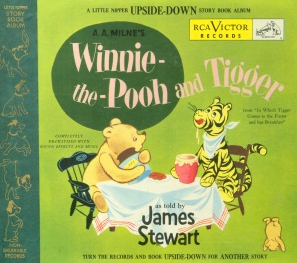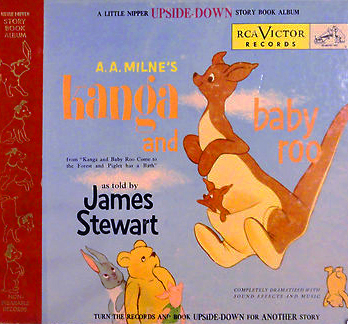Disney’s Winnie the Pooh on Records
The second featurette in the Pooh series made its debut on vinyl before the film’s release with several cast changes and a different musical approach, featuring Sterling Holloway as Pooh and the narrator.

WALT DISNEY Presents
WINNIE THE POOH AND THE BLUSTERY DAY
Disneyland Records – Storyteller Series STER-3953 (12” 33 1/3 RPM LP with Book)
Released in 1967. Executive Producer: Jimmy Johnson. Producer/Arranger/Conductor: Camarata. Running Time: 23 minutes.
Voices: Sterling Holloway (Narrator, Pooh); Robie Lester (Piglet, Kanga, Roo); Sam Edwards (Tigger, Owl); Dal McKennon (Gopher); Thurl Ravenscroft (Eeyore); Jon Walmsley (Christopher Robin); Barbara Luddy (Kanga); The Jack Halloran Singers.
Songs: “Winnie the Pooh”, “A Rather Blustery Day”, “The Wonderful Thing About Tiggers”, “The Rain Rain Rain Came Down Down Down”, “Hip Hip Pooh Ray” by Richard M. Sherman and Robert B. Sherman.
The Disneyland Records version of Disney’s second Pooh featurette—an Oscar-winner—is not the soundtrack. But what it might lack in that department it gains in other respects. (There would be no Pooh film soundtrack material until a few songs were released as a medley on Ovation Records’ The Magical Music of Walt Disney LP set; and later in some CD compilations. Most of today’s Pooh recorded songs are very accurate studio re-creations of the soundtracks).
 Back in the day, an innovative arranger/conductor like Tutti Camarata might have felt that it was part of his role to make the non-soundtrack songs different in tone—but not in spirit—to the film versions. In the case of the Pooh films, the songs were short and did not always have a structure that lent themselves to tracks on an album. Pooh LP’s, singles and read-alongs were strong, steady sellers for Disneyland Records, so songs that “traveled well” for any number of uses made lots of sense in a business as well as creative way.
Back in the day, an innovative arranger/conductor like Tutti Camarata might have felt that it was part of his role to make the non-soundtrack songs different in tone—but not in spirit—to the film versions. In the case of the Pooh films, the songs were short and did not always have a structure that lent themselves to tracks on an album. Pooh LP’s, singles and read-alongs were strong, steady sellers for Disneyland Records, so songs that “traveled well” for any number of uses made lots of sense in a business as well as creative way.
Three original cast members came to the Sunset Sound studio microphones to make this album: the wonderful Barbara Luddy (who also voiced Lady and Merryweather); Jon Walmsley (who was only a few years from playing Jason on the long-running TV series, The Waltons); and Sterling Holloway, who narrates the story plays Pooh. Holloway does not narrate in Pooh’s character (it was common on Disneyland Records for the narrator to be in character), and perhaps that would not be suitable for gentle, befuddled Pooh.
The other actors are part of what truly was a stock company for the Disneyland label: Robie Lester, Dal McKennon, Sam Edwards and Thurl Ravenscroft (who sounds as if he was recorded separately from the others).
Sam Edwards brings a certain gruffness to Tigger, while doing a voice somewhat like Paul Winchell did in the films. For many Disney fans of the late 1960’s, though, Edwards’ Tigger was the one they knew most, as the Pooh films would not be shown widely until well into the ’70s. With the coming of home video and the transition from vinyl in the ’80s, Edwards’ version of Tigger faded into the past. The only strange thing about Edwards’ performance occurs when he, as Tigger, introduces himself to Pooh and spells his name as “I-I-double T-I, double-GEAR” instead of “T-I-double-GUH-ERRR.”
The high level of musical and sound quality of the Disneyland products of this period is very much in evidence on this album, the only stereophonic Pooh LP based on a film. The arrangements are bright and cheerful, with an aural presence that fills a room or a set of headphones. Camarata’s sense of acoustics was renowned in the music world.
GIVE A LITTLE LISTEN
“The Wonderful Thing About Tiggers”
This is the first version of the song on vinyl records available (most of which are pictured in this video) for at least two decades before the soundtrack version was released on CD. It was the first to include the second verse (until The Tigger Movie) and the first in stereo. Sam Edwards was a member of the Disneyland Records “stock company” and appeared on camera and off in dozens of films, TV shows, cartoons and recordings.

WINNIE THE POOH STORIES
Told by James Stewart
RCA Victor Records AYL-4447(e); RCA Camden CAS-1008(e) (12” 33 1/3 RPM LP / Enhanced Mono / Side Two Only; Side One: “The Little Engine That Could” / 39 minutes)
Originally Released on 45 and 78 RPM Little Nipper Records in 1951 with illustrations by Mel Crawford; Reissued on LP in 1960.
Producer: Composer/Conductor: Norman Leyden. Adaptation: Steven R. Carlin.
Voices: James Stewart (Narrator); Cecil Roy (Pooh); Arnold Stang (Rabbit), Madeleine Pierce (Piglet); Frank Milano (Owl); Sandy Fussell (Christopher Robin); Merrill Joels (Eeyore); Betty Jean Tyler (Kanga).
Stories: “Winnie the Pooh and The Heffalump”; “Kanga and Baby Roo”; “Winnie the Pooh and Eeyore”; “Winnie the Pooh and Tigger”.
RCA’s recorded stories of A.A. Milne’s beloved stories are among the earliest on disc. They sold for many, many years, first on 78 and 45 RPM records. Two stories were included with a book that flipped over for one story or the other. The books went away when the recordings were reissued (with more “artsy” cover illustrations), and when the LP album combined all the stories with “The Little Engine That Could” told by Paul Wing.
 It’s odd that RCA didn’t cash in on the popularity of the Disney films by repackaging the same album that emphasized Pooh, but by the mid-’60s, RCA was probably selling more records by The Monkees to kids than traditional children’s records, even if they were recorded by the likes of Jimmy Stewart.
It’s odd that RCA didn’t cash in on the popularity of the Disney films by repackaging the same album that emphasized Pooh, but by the mid-’60s, RCA was probably selling more records by The Monkees to kids than traditional children’s records, even if they were recorded by the likes of Jimmy Stewart.
As a children’s record narrator, Stewart’s genial warmth trademark way of speaking makes him, total perfection. The Pooh scripts even allow him to interact with the characters. One can only speculate how many more records—and cartoon voices—he might have done, though for some reason, he did not. Yet Stewart loved doing radio comedy and drama, so there did not shy away from working in audio. Imagine how great it would have been if he narrated a Rankin/Bass special!
Norman Leyden, who composed and conducted music for dozens of RCA children’s records, has a signature style with repeated musical passages that he uses to punctuate story points or to underline specific characters.
GIVE A LITTLE LISTEN
The Adventures of Winnie the Pooh
All four of the RCA Pooh records are included here. The similarities and differences between the RCA and Disney versions are interesting, particularly in the casting of Arnold Stang (Top Cat, Famous Studios’ Herman the Mouse) and Cecil Roy (Famous Studios’ Little Lulu). He makes an excellent Rabbit, and remarkably similar to Junius Matthews’ Disney interpretation, but with a different edge.





 GREG EHRBAR is a freelance writer/producer for television, advertising, books, theme parks and stage. Greg has worked on content for such studios as Disney, Warner and Universal, with some of Hollywood’s biggest stars. His numerous books include Mouse Tracks: The Story of Walt Disney Records (with Tim Hollis). Visit
GREG EHRBAR is a freelance writer/producer for television, advertising, books, theme parks and stage. Greg has worked on content for such studios as Disney, Warner and Universal, with some of Hollywood’s biggest stars. His numerous books include Mouse Tracks: The Story of Walt Disney Records (with Tim Hollis). Visit 





















































As a child, I found several things “pooh-plexing” about the “Blustery Day” album when I first heard it on Christmas Day 1968, especially as it followed the high production values of the “Honey Tree” album of a year or two previously. Instead of Sebastian Cabot, the story was narrated by Winnie-the-Pooh himself–but he narrated it as though he didn’t have anything to do with the story (third person). This is because Sterling Holloway neglected to differentiate between his “Pooh” voice and his “Narrator” voice, but used the same voice for both roles. (With Holloway narrating, the story should have been told from Pooh’s point of view–it would have cleared up the confusion.)
Also certain portions of the story are not made clear without the visual references in the animation. When Piglet asks “Did you do that?” and Pooh replies “I don’t think so” there is absolutely no context to indicate that Owl’s house has just been blown down by the wind. There are not even any sound effects covering this dramatic moment. Only when Holloway-as-narrator describes the house coming down a moment later does the exchange begin to make sense.
There is also a moment between Pooh and Tigger that is very unclear. When
Tigger, who has been playing around with his image in the mirror, says to Pooh “Is he gone?” Pooh says “All but the tail” which is not explained on the record. In the film, Pooh says this when he is looking at Tigger’s image in the mirror as he hides and only the striped tail is showing. It makes sense in context of the animated film, but as dialogue which is not always adequately supported by the narrative it is incomprehensible.
The absence of the “Heffalumps and Woozles” song puzzled me, too. I had heard snatches of it in the previews and had been eagerly awaiting a chance to hear this song in its entirety…especially in light of all of the plush toy Heffalumps and Woozles being sold at Sears in anticipation of this film’s release. There is a pause in the narrative where the song should go when Holloway says “Naturally, he dreamed about Heffalumps and Woozles.” (I have since made myself a copy of this recording that inserts the song where it should go.) The absence of this song was the biggest disappointment–especially as there was a two-page spread in the picture book depicting Pooh’s “nightmare.”
The waterfall sequence was another scene that did not live up to its potential–with almost no sound effects, the imminent danger that Pooh and Piglet are in is almost trivialized.
Despite the excellent voice work done for this album, it never quite reached its potential. Someone in production needed to listen to the album before releasing it–to realize that it did not fully tell the story in audio form but left some mystifying gaps that wouldn’t be cleared up until one saw the animated version on the screen. Of course, the album was largely a “teaser” for the movie experience, but still it should have been able to stand on its own better than it does. But that’s only my opinion, of course.
Anybody else remember those plush Heffalump and Woozle toys? There were so many I doubt that any one household could have collected them all. We had quite a fair number of them, but there were many more on the store shelves–a very popular item that Christmas.
All very valid points, especially the “Did you do that?” part, which “Poohplexed” me, too.
I think the reason “Heffalumps and Woozles” was never recorded until the ’90s was that the albums were made far in advance of the finished film. That severely limited access to background music, approved dialogue, and songs that might have been added if these resources were available.
But that’s no excuse for sloppy mistakes — except for limited studio production time — and you are right about those. I do think the Honey Tree is superior as far as overall production, but I love the more elaborate musical direction on the songs.
Thanks once again to all commenters for adding so much value to these posts!
I think the reason “Heffalumps and Woozles” was never recorded until the ’90s was that the albums were made far in advance of the finished film. That severely limited access to background music, approved dialogue, and songs that might have been added if these resources were available.
Similarly, the depiction of Tigger and Piglet in the illustrations looked nothing like them in the film, too! I’m sure that was another case of getting this planned ahead before the final designs were laid out.
But that’s no excuse for sloppy mistakes — except for limited studio production time — and you are right about those. I do think the Honey Tree is superior as far as overall production, but I love the more elaborate musical direction on the songs.
Can’t fault this LP for that, I’m sure it confused plenty of kids to hear Holloway’s narration and not think it’s Pooh talking in third person all the time.
Guess they couldn’t get Howard, Hal, or Sebastian to do the Disney record.
Nor Paul Winchell (Tigger) or Jon Fielder (Piglet) for the Disney version.
This sort of thing is usually due to time, availability and budget. Except for Thurl, everyone on the record was in the same recording booth at Sunset Sound (the booth is still there), which means that they could record multiple albums in one session — a huge time and money saver.
Greg:
Another great post! Jimmy Stewart did a superb job narrating,,Arnold Stang was an ideal Rabbit And Cecil Roy made an interesting Pooh.Though I’m more used to a Paul Winchell Tigger,Sam Edwards did his best doing the bouncey feline! Thanks again!
Reminded I picked up the Blustery Day LP at a thrift store a while back. The copy I have must be a reissue as it has the rainbow banner on the label and the catalog number doesn’t have the “ST” designation on the cover. so I guess I’m stuck with a mono version if that’s the case (haven’t listened to it yet).
Chris,
You most likely have a stereo copy. I don’t think this album was even released in mono. The catalog numbers started to contradict themselves in the late ’60s. The stereo albums originally had “STER” prefixes but later an “ST” or a “DQ” could be stereo. Both Stories from The Mouse Factory and The Aristocats and Other Cat Songs are stereo with “ST” prefixes, yet The Aristocats Storyteller album, which is marked as stereo, is completely mono except for some of Sterling Holloway’s dialogue.
Thanks Greg, I guess that would’ve been a little too late in the game for needing to make separate LP’s for both types then.
Actually, RCA Victor’s involvement with Winnie the Pooh goes back to around 1933.
That year, Victor issued a set of three “Winnie The Pooh and Christopher Robin Songs” records (numbers 221, 222 and 223), which were seven-inch picture discs. The set sold for two dollars–at the time. Nowadays, if you can find it, it’ll go for hundreds of dollars.
These recordings may have been Frank Luther’s first “kiddie’ discs. He had emerged as a general pop singer, doing many vocal refrains on dance records, over the previous five years. During that same time, he was part of a trio known variously as the ,Melody Three and the Edisongsters (with the other two being Jack Parker and Phil Dewey).
Luther had also been singing fake country songs for various and sundry labels out of New York. For four years, Frank Luther partnered up with Carson Robison, and they introduced a number of successful pieces, including “Barnacle Bill The Sailor”. After they had split up, Luther continued to record pseud-hillbilly numbers, often with his wife Zora Layman and with Leonard Stokes.
Illustrations of these Winnie-the-Pooh discs can be seen on page 182 of “The Collector’s Guide to Victor Records” by Michael W. Sherman (Monarch Record Enterprises, 2010).
One last possible cartoon connection: Frank Luther’s brother sometimes worked with him and with Carson Robison,, using the name of “Phil Crow”. (I suspect that “Crow” may have been the family name all along.) In 1973, a “Phil Luther, Jr.” appeared in the voice cast of “Speed Buggy” as Tinker, that show’s analogue to Shaggy on “Scooby-Doo”.
A nephew to Frank Luther, perhaps?
Anyone remember the record where Pooh described his “fauther” ? I was trying to explain it — but I can’t remember much!
bud werner library has winnie the pooh and the blustery day on display